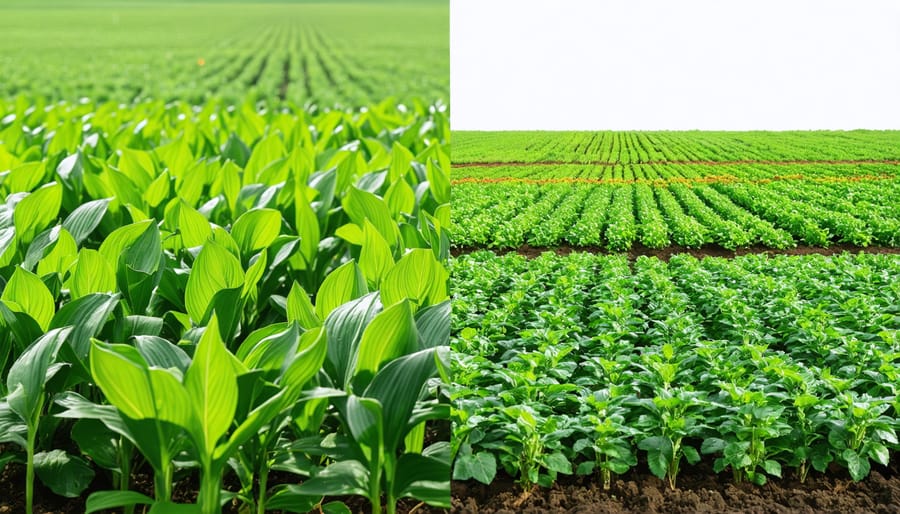Biodiversity loss threatens far more than just our planet’s wildlife – it directly impacts your health, food security, and overall well-being. As Canadian ecosystems face unprecedented challenges, from climate change to habitat destruction, the disappearance of plant and animal species creates ripple effects that touch every aspect of our lives. Critical medicines derived from natural compounds become harder to discover, crop yields decrease without essential pollinators, and our mental health suffers as we lose connection with diverse natural spaces.
Research shows that regions with declining biodiversity experience higher rates of infectious diseases, reduced access to nutritious traditional foods, and compromised air and water quality. In Canada alone, over 800 species are currently at risk, with each loss potentially disrupting vital ecosystem services we depend on – from natural water filtration to carbon storage.
This isn’t just an environmental crisis – it’s a public health emergency that requires immediate action. Understanding how biodiversity loss affects our daily lives helps us recognize the urgent need to protect and restore the delicate web of life that supports human health and wellness. By examining these impacts, we can better appreciate why preserving biodiversity is crucial for our own survival and well-being.
Your Food Security at Risk

Nutritional Quality Under Threat
The loss of biodiversity directly impacts the nutritional quality and variety of our food supply. As species diversity decreases, we’re seeing a concerning decline in nutrient-rich food sources that have traditionally supported healthy diets. Research shows that modern agricultural practices and environmental changes affecting soil quality and nutrition are leading to less nutritious crops compared to those grown decades ago.
Wild food sources, which often contain higher levels of essential nutrients than their cultivated counterparts, are becoming increasingly scarce. Traditional Indigenous food systems, which rely on diverse local species, are particularly vulnerable to these changes. For example, many berries native to Canadian forests contain powerful antioxidants and vitamins that aren’t easily replaced by conventional alternatives.
The reduction in crop diversity also means we’re becoming more dependent on a limited number of food sources. This not only affects our ability to maintain a varied, nutrient-rich diet but also makes our food system more vulnerable to pests and diseases. Foods that were once common in traditional Canadian diets, such as specific varieties of wild rice and certain fish species, are becoming harder to find.
To maintain optimal nutrition, it’s important to support local biodiversity conservation efforts and choose diverse food sources when available. Consider incorporating seasonal, locally-grown varieties into your diet and learning about traditional food systems in your region.
Food System Vulnerability
The loss of biodiversity directly impacts our food systems and the security of our food supply. When we reduce the variety of crops and their wild relatives, we diminish the genetic diversity that helps our food plants resist diseases, pests, and changing climate conditions. This vulnerability becomes particularly concerning for Canadian agriculture, where climate variations can already pose significant challenges.
Traditional farming practices often relied on multiple crop varieties, each adapted to specific conditions. Today, our increasing dependence on a limited number of crop species makes our food production more susceptible to large-scale failures. For example, if a disease affects a widely-used wheat variety, it could impact a substantial portion of Canadian grain production.
Pollinators play a crucial role in our food security, with about one-third of our food crops depending on these beneficial insects. The declining diversity of wild pollinators threatens crop yields and the stability of our food production systems. This affects not only farm productivity but also the nutritional quality of our diets.
To build resilience in our food systems, agricultural experts recommend diversifying crop varieties and protecting natural habitats that support beneficial insects and other wildlife. By maintaining biodiversity in agricultural landscapes, we can help ensure more stable food production and better nutritional outcomes for Canadian families.
Natural Medicine Sources Disappearing

Medical Research Setbacks
The loss of biodiversity poses significant challenges for medical research and drug development, impacting our ability to discover new treatments for various health conditions. Many of our most important medications, from pain relievers to cancer treatments, were originally derived from plants, animals, and microorganisms found in nature.
For example, the Pacific Yew tree provided scientists with taxol, a crucial compound used in cancer treatment. As species disappear, we lose potential sources of new medicines before we can study them. Scientists estimate that less than 10% of the world’s plant species have been investigated for their medicinal properties.
This loss particularly affects research into antibiotics, where new discoveries are urgently needed to combat antibiotic resistance. Many microorganisms in soil and marine environments could hold solutions to this growing health challenge, but habitat destruction threatens these potential resources.
Traditional Indigenous knowledge about medicinal plants also becomes irreplaceable when species are lost. Many Canadian Indigenous communities have extensive knowledge of local plants’ healing properties, which could guide modern medical research. Protecting biodiversity is therefore essential for future medical breakthroughs and the preservation of traditional medical knowledge.
Traditional Medicine Challenges
Traditional medicine practices, deeply rooted in Canada’s Indigenous communities and cultures worldwide, face significant challenges due to declining biodiversity. Many healing traditions rely on specific plants, herbs, and natural compounds that are becoming increasingly rare or extinct due to habitat loss and environmental changes.
For generations, Indigenous healers have used plants like sage, sweetgrass, and cedar for their medicinal properties. However, these valuable resources are becoming harder to find in their natural habitats. The loss of medicinal plants not only impacts physical health treatments but also affects cultural practices and traditional knowledge transmission to younger generations.
This decline particularly affects communities that depend on natural remedies for primary healthcare. In Canada, many Indigenous communities still rely on traditional medicine as an important part of their healthcare practices. The disappearance of medicinal plants can lead to the loss of affordable, culturally appropriate healthcare options.
Beyond the immediate health implications, the loss of these natural medicines represents a significant decline in humanity’s collective medical knowledge. Many modern pharmaceuticals were originally derived from natural compounds, and declining biodiversity means potentially losing undiscovered treatments for various health conditions.
Mental Health and Nature Connection

Green Space Benefits
Research consistently shows that diverse ecosystems play a crucial role in supporting our mental wellness and overall health. The health benefits of green spaces are particularly significant when these areas maintain rich biodiversity.
Natural environments with varied plant and animal species create multi-sensory experiences that help reduce stress and anxiety. The sound of different bird species singing, the sight of colorful wildflowers, and the presence of butterflies and other pollinators work together to create a calming atmosphere that promotes mental restoration.
Studies conducted in Canadian urban parks have found that spaces with greater biodiversity offer enhanced psychological benefits compared to more uniform landscapes. People who spend time in these diverse environments report improved mood, better concentration, and reduced symptoms of depression.
These benefits are especially relevant for urban Canadians, where access to biodiverse green spaces can provide a much-needed respite from city life. Regular exposure to varied natural environments has been linked to better sleep quality, increased creativity, and stronger immune system function.
To maximize these benefits, experts recommend spending at least 20 minutes daily in natural settings, particularly those featuring diverse plant and animal species. Even small urban gardens and community parks can support mental wellness when designed to incorporate various native species and natural elements.
Stress and Anxiety Effects
The accelerating loss of biodiversity in our natural environments is creating significant challenges for our psychological well-being. Research shows that environmental stress on mental health increases as local ecosystems deteriorate, leading to heightened anxiety and emotional distress.
Canadians who regularly interact with nature often report feeling a deep sense of loss when familiar species disappear from their local environments. This phenomenon, known as ecological grief, can manifest as persistent worry, sadness, and increased stress levels. The disruption of traditional connections to land and wildlife particularly affects Indigenous communities, whose cultural identity and mental wellness are closely tied to biodiversity.
Studies indicate that reduced access to diverse natural environments can lead to:
– Increased symptoms of anxiety and depression
– Higher stress levels in urban areas
– Decreased emotional resilience
– Reduced ability to cope with daily challenges
– Diminished sense of place and belonging
However, there are positive steps we can take to protect our mental well-being. Engaging in local conservation efforts, creating wildlife-friendly spaces in our communities, and maintaining regular contact with remaining natural areas can help buffer against these psychological impacts. Supporting biodiversity protection initiatives also gives us a sense of agency and hope, which are crucial for maintaining good mental health in the face of environmental changes.
Disease Risk and Immune Health
Emerging Disease Patterns
The disruption of natural ecosystems through biodiversity loss has created concerning patterns in disease emergence and spread across Canada and globally. As natural habitats shrink and wildlife populations decline, we’re seeing more frequent contact between humans and disease-carrying animals, leading to increased health risks. This relationship between ecosystem degradation and health has become particularly evident in recent years.
When ecosystems lose their diversity, they become less resilient to pathogens, creating opportunities for disease-causing organisms to thrive. For example, the loss of predator species can lead to overpopulation of rodents and other small mammals that often carry diseases transmissible to humans. In Canadian forests, the decline in biodiversity has been linked to increased rates of Lyme disease as tick populations grow unchecked.
Healthy, diverse ecosystems naturally limit disease spread through what scientists call the “dilution effect.” This means that when multiple species are present, diseases are less likely to spread rapidly because pathogens encounter resistance from various hosts. However, as biodiversity decreases, this natural protection weakens, potentially exposing Canadians to new health threats.
The good news is that protecting and restoring biodiversity can help reduce these disease risks. By supporting conservation efforts and maintaining healthy ecosystems, we can create natural barriers against disease emergence while preserving the environmental balance essential for public health.
Immune System Impacts
The loss of biodiversity has significant implications for our immune system health and resilience. Research shows that exposure to diverse microorganisms in our environment helps train and strengthen our immune system, particularly during childhood development. When we lose biodiversity in our surroundings, we also lose access to these beneficial microbes that help regulate our immune responses.
Studies have found that people living in areas with greater biodiversity tend to have lower rates of allergies and autoimmune conditions. This connection, known as the “biodiversity hypothesis,” suggests that regular contact with various plants, animals, and microorganisms helps our bodies develop proper immune responses.
The decline in environmental diversity also affects the composition of our gut microbiome, which plays a crucial role in our immune function. A healthy gut requires exposure to diverse beneficial bacteria, many of which come from our interaction with nature. When biodiversity decreases, we lose access to these important microorganisms.
Additionally, many medicines and treatments that support immune function come from natural sources. The loss of plant and animal species means potentially losing valuable compounds that could help fight diseases and boost immunity. For example, many traditional medicines used by Indigenous peoples in Canada rely on specific plants that are now becoming increasingly rare.
To support immune health, health experts recommend spending time in natural environments, particularly those with rich biodiversity. Activities like gardening, hiking in natural areas, and consuming locally grown foods can help maintain beneficial exposure to environmental microorganisms.
Every Canadian can play a vital role in protecting biodiversity and, by extension, their own health. Start by supporting local conservation efforts through volunteering or donations to environmental organizations. Creating wildlife-friendly spaces in your backyard or community garden helps maintain local biodiversity – plant native species, avoid pesticides, and provide water sources for birds and insects.
Make sustainable food choices by purchasing locally grown, organic produce when possible and reducing food waste. Consider joining a community-supported agriculture program to support local farmers who use biodiversity-friendly practices. Minimize your carbon footprint through simple actions like using public transit, cycling, or walking when feasible.
Advocate for biodiversity protection by engaging with local government officials and supporting policies that preserve natural habitats. Participate in citizen science projects that monitor local wildlife and plant species, contributing valuable data to conservation efforts.
Education is equally important – share knowledge about biodiversity’s importance with family and friends, particularly children. Join or organize nature walks and outdoor activities that help people connect with local ecosystems. Remember that small actions, when multiplied across communities, create significant positive impact.
By taking these steps, you’re not just protecting nature – you’re investing in your own health and the wellbeing of future generations. Start with one action today and gradually incorporate more as you build sustainable habits.

